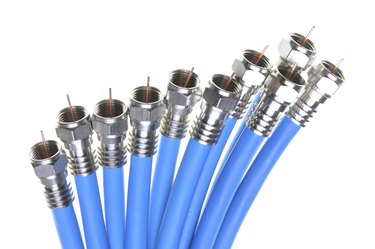
Homes built in the 70s and earlier may have 300-ohm twin-lead cable already present that you may need to replace. Many modern homes have 75-ohm coaxial wire that is widely used for cable and satellite television service. The two types of cable have different characteristics that affect how they're used. In addition, coaxial cable itself comes in several varieties, each of which is appropriate for different circumstances.
300-Ohm Twin-lead Wire
Video of the Day
Twin-lead 300-ohm antenna wire is a flat cable that contains two parallel conductors, one on each side, protected by a sturdy plastic jacket. Many older antennas have connectors only for 300-ohm cable, although few if any modern TVs do. The cable is suitable for radio and television signals. Although it bends more easily than coaxial cable, it suffers from interference and signal loss if installed too close to pipes, nails, gutters and other metal construction materials. You can reduce this problem by installing the wire with stand-offs -- hardware that puts a few inches between the cable and a building's metal parts.
Video of the Day
75-Ohm Coaxial Cable
Coaxial cable consists of a wire conductor that runs through the center of a plastic insulator, which is surrounded by a conducting shield. The shield is in turn covered with a tough plastic jacket. The shielded design blocks most types of electrical and radio interference, keeping the TV signal strong and clear, reducing the installation worries encountered with 300-ohm cable. The different kinds of 75-ohm cables are identified by a code that begins with "RG" and ends with a number, such as RG-6 and RG-59. Coaxial cables have end connectors that screw securely onto corresponding threaded posts, such as those found on antennas, television sets and other equipment. TV technicians sometimes refer to coaxial cable as coax, pronounced "co-ax."
Types of Coax
Although RG-59 is the type of coax wire used for cable and satellite TV in years past, it is now largely reserved for closed-circuit TV; it performs poorly with modern digital broadcasts. Instead, RG-6, RG-6 with quad-shield, and RG-11 work better for new installations. RG-6 represents a standard cable suitable for most indoor and some outdoor applications. RG-6 with quad-shield has four layers of shielding, better able to block radio interference. The added layers also strengthen the cable, helping it stand up to the stresses of weather extremes encountered with outdoor use. The more expensive RG-11 has a thicker central conductor that carries signals farther with less loss, making it well-suited to long cable runs, such as from an outdoor antenna to the house.
Cable Replacement
When replacing 300-ohm twin-line with coaxial cable, you may need to use an adapter called a balun between the 300-ohm connector on the antenna and the 75-ohm coaxial connector on the cable. The balun has a tiny transformer that matches the different ohm values; without it, the signal weakens considerably. You can also replace the antenna itself with one that has a coaxial connector. Upgrading RG-59 to RG-6 or other types of coaxial cable is more straightforward, as existing connectors will work and there's no concern about matching the impedance ohm values. Thicker coaxial cables don't bend as easily as thin ones, so be alert to potential trouble spots where it bends in an existing installation. When you're replacing twin-line with coaxial cable, the frequency and angle of bending is especially important, as twin-line is much more flexible than coax.
- Denny’s Antenna Service: TV Antenna Transmission Line - Coax Cable
- Sewell Direct: What Is the Difference between RG59 and RG6??
- University of Colorado; Common Coaxial Connectors
- Blue Jeans Cable: Video Cable Shielding
- Belden Cable: Shielding and Armoring
- Primus Cable: RG-11 Coaxial Cable Overview
- Blue Jeans Cable: What is Impedance, Anyway?